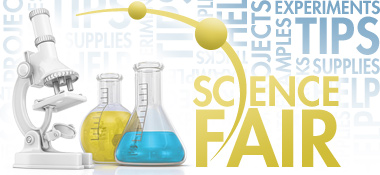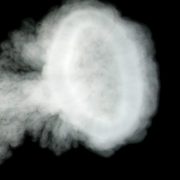Science Fair 911 – Scientific Method
 By Guest Blogger Debbie Leibold
By Guest Blogger Debbie Leibold
So you have a great science fair project idea, but you’re not sure how to get started? We’re here to help!
Every successful science fair project starts with the Scientific Method. The Scientific Method is just a road map to get you from your question to your answer. Follow these steps to make your experiment amazing!
Question
Find a topic that interests you and decide what you want to learn from the project. Remember to pick a topic that is narrow enough for you to become an expert on one specific aspect of that topic. For more information on choosing a topic, see our first Science Fair 911 blog post or check out the science fair section at www.SteveSpanglerScience.com.
Research
Gather information about the question you want to explore. By doing some research ahead of time about your subject, you will be able to narrow down your question and figure out exactly what it is you want to find out. You will also have some background knowledge that will help you to understand the results of your tests and possibly lead you to some meaningful conclusions.
Hypothesis
Before you can actually start your experiment, you need to come up with a hypothesis. A hypothesis is an educated guess about what you think might happen in your experiment. What do you think the answer is to your question? We like to call the hypothesis the “I Think Statement.” After you have done some preliminary research and thinking about your project, all you have to do is write out what you think will happen. Write it in ink! Why, you ask? Ink can’t be erased, that’s why. Under no circumstances are you allowed to change your hypothesis. You don’t have to be right. Your hypothesis is a guess. There is no shame if your results don’t turn out the way you think. In fact, some of the world’s greatest scientific discoveries happened when other experiments went wrong. So push yourself and try something unusual. It’s no fun at all if you already know the answer before you start!
Procedure
Once you’ve written down your hypothesis, think through and write out every step you’re going to take to run your tests. Your procedure is the plan you are going to follow to get your data. It is crucial that your procedure is clear and easily understandable so that you can share it easily at the science fair, but also so that others who are WOWED by your experiment can go home and duplicate it themselves. Don’t cut corners in writing out your steps. Include everything so that if others follow your procedure they’ll achieve the same results. Think of your procedure as a recipe. If you leave out an ingredient or a step, it doesn’t work!
Data
Now that you’ve written out the steps you’re going to take, go ahead and get started! Follow your steps and see what happens. The results of your experiment make up your data. It is very important for you to track your results as you go instead of waiting until all your tests are done. Keep a notebook or journal where you can jot down your results or discoveries as they happen. Record how you changed the variable and show what happened as a result. The data is the most important part of the experiment because it will be analyzed to see if your hypothesis is correct.
You should consider running multiple tests to ensure that your results are correct. By averaging several sets of data instead of just counting on one trial (let’s say of the distance a marble travels down a surface), you can account for minor differences in technique, angle, measurement errors, etc. Real-life scientists don’t ever just run one test and conclude that their hypothesis was right or wrong. Many tests are run to prove that the data is accurate.
Take pictures of your experiment to capture what happens. Those photos add great color and pizzazz to your science fair display board. Add captions to the photos and you’ve got a really professional looking board. A parent or a friend with a video camera is a great way to be able to replay your experiment to really analyze what happened.
Photos and videos aren’t specific measurements, however. You need to create some kind of measurement scale—that scale might be as simple as a ruler or a tape measure—but the more numerical your data can be, the more specific your results and conclusion can be. When you have numerical data, it is helpful to organize that data in tables, charts, and/or graphs. Entering your data into an Excel spreadsheet will allow you to generate very sophisticated looking, color-coded graphs of your results. The more visual you can make your results, the better!
Observations/Discoveries
So you’ve done your experiment and documented your results. What did you discover? Write down what happened in your tests and any other observations you made along the way.
Think of your experiment like a CSI investigation. A mystery needs to be solved (your question) and all of the little pieces of data you find along the way serve as the evidence. Many different pieces of evidence may exist, but eventually all of those pieces of the puzzle fit together and, at the very end, the detective (in this case the scientist—you!) figures out “who dunnit.” The mystery is solved—the question is answered—and it’s time to broadcast to the world what you discovered.
Discoveries are very different from conclusions, and it’s important to know the difference. For example, dropping Mentos mints into soda creates an eruption. That’s a discovery (not a conclusion) and this discovery leads to more questions. Each test result leads you to make a new discovery. Discoveries are observations with no right or wrong answer. Only after you’ve made a number of discoveries can you formulate a conclusion.
Conclusion
Was your hypothesis correct? Base your answer on your data after analyzing notes, photos, videos, charts, and graphs. Your conclusion is not an opinion… it is a fact based on the tests you conducted and the discoveries you made. In the Mentos example above, your conclusion might be that there is a relationship between the number of Mentos you drop into the soda and the height of the geyser and that your hypothesis was correct when you thought that putting ten Mentos in the soda would produce a larger geyser than putting five Mentos into the soda.
Again, it is absolutely okay if your hypothesis was incorrect. Say proudly, “I was wrong, but (and this is the best part) this is why I think so…” Those thoughts about what you might do differently or about what went wrong make great ideas for next year’s science fair project… or they might just keep you and your friends busy next weekend.
You could also add a section to the conclusion that I like to call the “So what?” So what’s the bigger picture? Why is this important? What did you learn? Think of the conclusion like a conclusion paragraph in an essay. Remind us of what you were trying to prove (your hypothesis), review your main points or discoveries, and make some final remarks about the project as a whole.
I don’t know about you, but for me, having a guide to follow makes the science fair seem much less overwhelming! Following the steps of the Scientific Method will lead you down the right path and help you turn your great idea into a fantastic science fair project.
For more information on how to do a science fair project or to see some sample projects, visit the science fair section at www.SteveSpanglerScience.com.
Tune in next Monday for some more helpful hints about science fair!





Trackbacks & Pingbacks
[…] Scientific Method January 23rd […]
Leave a Reply
Want to join the discussion?Feel free to contribute!